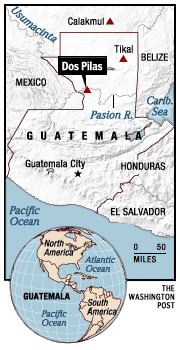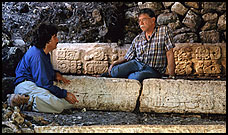 |
 |
Step by Step, Bloody Tale of Maya Conquest
Science: Newly found glyphs on a stairway indicate ruler of a third
city was behind a 'world war' long thought a rivalry of two brothers.
 |
 |
By THOMAS H. MAUGH II
TIMES STAFF WRITER
A hieroglyphic stairway exposed last fall by a hurricane at the Maya
city of Dos Pilas tells the story of the brutal and bloody war between
two superpowers that
were trying to dominate their known world.
A new translation of the epic tale fills a vital 60-year gap in Maya history during a period that set the stage for the ultimate collapse of the Maya civilization.
The leaders of the Maya cities of Tikal and Dos Pilas were brothers,
and historians have long believed that rivalry between them was at the
root of conflict between
the two cities. But the newly discovered inscriptions indicate that
it was a third party--Calakmul, in what is now Mexico--that triggered the
fighting in its attempts to
conquer the Maya empire.
"This carries back our history of the dynasty [at Dos Pilas] another
40 to 50 years and changes our entire interpretation of this region," said
archeologist Arthur
Demarest of Vanderbilt University. "This was not part of a dynastic
struggle between two brothers, but part of a world war."
Archeologists "are fascinated by the possibility that the Maya were
trying to create an empire, but were having difficulty making it work,"
added archeologist David
Friedel of Southern Methodist University. "We now know that the reason
they were having difficulty ... was because there were two great contending
rivals for
overlord in this period" and neither was able to achieve a definitive
success.
Dos Pilas is deep in the Guatemalan jungle near the Pasion River, which
was the superhighway of the Maya world. Many facts about the city have
intrigued
archeologists, posing puzzles that had no clear solutions. The city
seemed to have sprung up nearly overnight, reaching a population of nearly
5,000. Yet soils in the
region are very poor, and there was little or no evidence of farming
to support the city. It was not clear how and why it was established.
The new discovery, published in the October edition of the National Geographic magazine, seems to clear up many of those questions.
Several large hurricanes, including Iris, struck the region last fall,
and no one knows which exposed the steps. Demarest got a call from one
of his sources telling him
about the newly exposed steps and, fearing looting or other damage,
immediately organized an expedition to document the finding--borrowing
money on his
MasterCard to speed the process. Ultimately, the project was financed
by Vanderbilt, the National Geographic Society and the Foundation for Mesoamerican
Studies. Federico Fahsen of Vanderbilt, a noted Maya epigrapher, did
most of the actual excavation and translation.
The steps themselves "are in beautiful shape," Demarest said. "Some
parts look like they were carved yesterday." The team photographed them,
made replicas and
built roofs and other structures to protect them.
As Fahsen was translating the hieroglyphs, he was astonished by what
they said. "When I read those glyphs, I had to blink to make sure I was
reading them
correctly," he said. "I had never heard of Calakmul actually invading
and defeating the king of Dos Pilas. We thought that, at most, they may
have had a weak
alliance of some type."
The glyphs tell of the birth of a king, Balaj Chan K'awiil, on Oct.
15, AD 625, in Tikal. Four years later, Balaj Chan K'awiil was sent with
a military force to
establish the city of Dos Pilas, about 70 miles southwest of Tikal.
A stronghold in Dos Pilas allowed Tikal to exert control over the Pasion
River, the major trade
route between the highlands and lowlands for coveted items such as
jade, obsidian, quetzal feathers and shells from the Caribbean.
"Balaj Chan K'awiil became a very big warrior," Fahsen said. "He almost never stopped fighting and for many years was loyal to Tikal."
The steps tell about the ceremonies that the young man went through,
always as a friend of his brother, Nuun Ujol Chaak, the ruler of Tikal--not
as an enemy as
was previously believed.
The fly in the ointment was a ruler commonly known as Yuknom Cheen the
Great, who was the leader of a group of people who called themselves the
Kan, the
"snake people." His capital was Calakmul, in what is now Campeche state
in southeastern Mexico.
When Balaj Chan K'awiil was in his early 20s, Calakmul attacked and
defeated Dos Pilas. He was captured, but subsequently restored to the throne
as a "puppet
king" who was allowed to keep his land in exchange for allegiance to
the invader.
The record then describes how Balaj Chan K'awiil launched a decade-long
war against Tikal that ended in his victory. His forces sacked Tikal and
brought Nuun
Ujol Chaak--his own brother--and other Tikal nobles to Dos Pilas to
be sacrificed.
This section of the glyphs "was very graphic," Fahsen noted: "It says,
'Blood flowed and skulls of the 13 peoples of the Tikal palace were piled
up.' The final glyphs
describe the king of Dos Pilas 'doing a victory dance.' "
Dos Pilas then embarked on a campaign of conquest and became a major regional power.
The new findings appear to support the theory previously advanced by
Maya scholars Simon Martin of University College, London and Nikolai Grube
of the
University of Bonn that this period in Maya history was a "long world
war" between the superpowers of Tikal and Calakmul. Neither gained ultimate
ascendancy,
and power oscillated back and forth.
"After Tikal was sacked, it eventually roared back and crushed Calakmul,"
Demarest said. "And then the Maya world just broke up into regional powers,
setting the
stage for a period of intensive, petty warfare that finally led to
the collapse of the Maya."
By AD 760, Dos Pilas had been abandoned. And by the 9th century, the entire western Maya civilization had disintegrated.